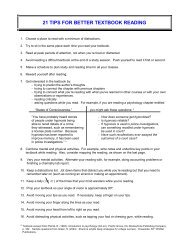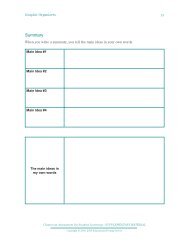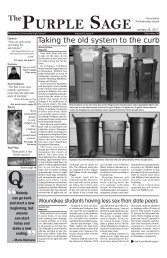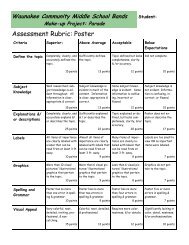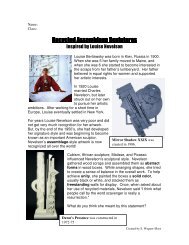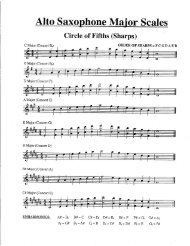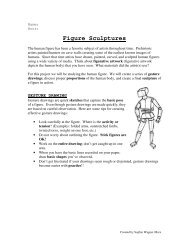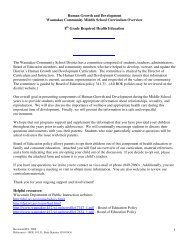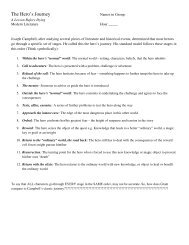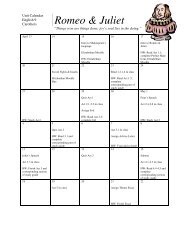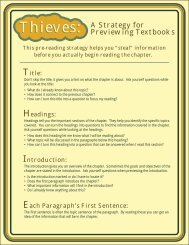Mascots and Other Public Appropriations of Indians and Indian ...
Mascots and Other Public Appropriations of Indians and Indian ...
Mascots and Other Public Appropriations of Indians and Indian ...
Create successful ePaper yourself
Turn your PDF publications into a flip-book with our unique Google optimized e-Paper software.
Citation:<br />
DeLoria, Philip J. "<strong>Mascots</strong> <strong>and</strong> <strong>Other</strong> <strong>Public</strong> <strong>Appropriations</strong> <strong>of</strong> <strong><strong>Indian</strong>s</strong> <strong>and</strong><br />
<strong>Indian</strong> Culture by Whites." Encyclopedia <strong>of</strong> North American <strong><strong>Indian</strong>s</strong>. 1996 ed.<br />
History Study Center. ProQuest Information <strong>and</strong> Learning. Waunakee High<br />
School LMTC. 17 Oct. 2006 .<br />
<strong>Mascots</strong> <strong>and</strong> <strong>Other</strong> <strong>Public</strong> <strong>Appropriations</strong> <strong>of</strong> <strong><strong>Indian</strong>s</strong> <strong>and</strong> <strong>Indian</strong> Culture<br />
by Whites<br />
Philip J. Deloria (Lakota ancestry), University <strong>of</strong> Colorado at Boulder<br />
When the Florida State Seminoles football team rushes onto the field, it follows the<br />
university's mascot--a stereotyped <strong>Indian</strong> warrior with colored turkey feathers <strong>and</strong> a<br />
flaming spear, which is planted in the end zone with a whoop. Florida State's fans, many<br />
in <strong>Indian</strong> costume themselves, then proceed to chant a faux-<strong>Indian</strong> melody, swinging<br />
their arms in a synchronized "tomahawk chop." The Florida State experience is a<br />
common one. "<strong><strong>Indian</strong>s</strong>"--in a variety <strong>of</strong> flavors ranging from warriors, red men, braves,<br />
<strong>and</strong> chiefs to "Fighting Sioux" <strong>and</strong> "Apaches" have been the most consistently popular<br />
mascot in American athletic history.<br />
The University <strong>of</strong> Wisconsin at Lacrosse first named its teams <strong><strong>Indian</strong>s</strong> in 1909. In 1912,<br />
the Boston Braves baseball team followed suit, <strong>and</strong> three years later, Clevel<strong>and</strong>'s baseball<br />
club also became the <strong><strong>Indian</strong>s</strong>. During the 1920s, many college <strong>and</strong> pr<strong>of</strong>essional teams-including<br />
teams at Stanford, Dartmouth, <strong>and</strong> the University <strong>of</strong> Illinois, as well as the<br />
Chicago Black Hawks hockey club--adopted <strong>Indian</strong> names. The practice filtered down to<br />
thous<strong>and</strong>s <strong>of</strong> high schools <strong>and</strong> junior high schools seeking institutional identities. Today,<br />
pr<strong>of</strong>essional sports boasts five major clubs that use "the <strong>Indian</strong>" as a name <strong>and</strong> mascot. In<br />
addition to Chicago <strong>and</strong> Clevel<strong>and</strong>, Atlanta has the Braves, Kansas City has the Chiefs,<br />
<strong>and</strong> Washington, D.C., has the Redskins. While some colleges <strong>and</strong> universities--including<br />
Stanford <strong>and</strong> Dartmouth--have dropped their <strong>Indian</strong> logos <strong>and</strong> mascots, many more<br />
continue to insist that their use <strong>of</strong> <strong>Indian</strong> stereotypes is harmless fun.<br />
Americans' embrace <strong>of</strong> <strong>Indian</strong> mascots was only part <strong>of</strong> a broad, early-twentieth-century<br />
primitivist nostalgia that stamped <strong>Indian</strong> imagery on a nickel, positioned baskets <strong>and</strong><br />
pottery in the "<strong>Indian</strong> corners" <strong>of</strong> arts-<strong>and</strong>-crafts revival homes, <strong>and</strong> permeated the rituals<br />
<strong>of</strong> Boy Scouts <strong>and</strong> Campfire Girls. At the turn <strong>of</strong> the century, many Americans perceived<br />
that the story they had been telling themselves about their origins <strong>and</strong> character--one <strong>of</strong><br />
frontier struggle between bold adventurers <strong>and</strong> savage <strong><strong>Indian</strong>s</strong>--had lost much <strong>of</strong> its<br />
cultural power as historians <strong>and</strong> critics declared the frontier "closed." On the<br />
contemporary side <strong>of</strong> this closed frontier, Americans saw the modern world--a place <strong>of</strong><br />
cities, immigrants, technology, lost innocence, <strong>and</strong> limited opportunity. Many Americans<br />
used a ritualized set <strong>of</strong> symbols--cowboys, <strong><strong>Indian</strong>s</strong>, scouts, <strong>and</strong> pioneers--to evoke the<br />
bygone "American" qualities <strong>of</strong> the frontier era: "authenticity," nature, community, <strong>and</strong><br />
frontier hardiness. Through summer camp <strong>and</strong> wilderness outings in "nature," touristic<br />
contact with the "authenticity" <strong>of</strong> <strong>Indian</strong> primitivism in the southwestern deserts, <strong>and</strong> an<br />
increased emphasis on rugged, character-building athletic competition, they sought to
eimagine "modern" compensatory experiences that might take the place <strong>of</strong> the now-lost<br />
"frontier struggle."<br />
Bringing <strong><strong>Indian</strong>s</strong>--potent symbols both <strong>of</strong> a nostalgic, innocent past <strong>and</strong> <strong>of</strong> the frontier<br />
struggle itself--into the athletic stadium helped evoke the mythic narrative being<br />
metaphorically replayed on the field. It was no accident that many other mascots-mustangs,<br />
pioneers, <strong>and</strong> so on--were also prominent characters in the athletic rendering <strong>of</strong><br />
the national story. <strong>Indian</strong> chiefs <strong>and</strong> braves represented the aggressiveness <strong>and</strong> fighting<br />
spirit that was supposed to characterize good athletic teams. This racial stereotyping<br />
justified an American history in which peaceable cowboys <strong>and</strong> settlers simply defended<br />
themselves against innately aggressive <strong><strong>Indian</strong>s</strong> in a defensive conquest <strong>of</strong> the continent.<br />
As mascots celebrated "<strong>Indian</strong>" ferocity <strong>and</strong> martial (read also athletic) skill, they were at<br />
the same time trophies <strong>of</strong> Euro-American colonial superiority: "<strong><strong>Indian</strong>s</strong> were tough<br />
opponents, but 'we' prevailed. Now we 'honor' them (<strong>and</strong> in doing so, celebrate<br />
ourselves)."<br />
The performative aspects <strong>of</strong> mascot ritual bring this American narrative to life, <strong>and</strong><br />
demonstrate to participants that their myths, enacted both on the athletic field <strong>and</strong> in the<br />
st<strong>and</strong>s, remain valid. The virulent response to <strong>Indian</strong> protests against <strong>Indian</strong> mascots<br />
demonstrates the deep emotional investment many Americans have made both in their<br />
imagining <strong>of</strong> <strong>Indian</strong> people as ahistorical symbols <strong>and</strong> in their sports affiliations. In mass<br />
society, athletic spectacles have become a deeply ingrained tradition to which many<br />
Americans turn for personal <strong>and</strong> social identities. The Florida State Seminole, then,<br />
signifies not only the frontieresque American character sought by early-twentieth-century<br />
fans, but also a more contemporary longing for the relative purity, simplicity, <strong>and</strong><br />
tradition <strong>of</strong> the early twentieth century itself.<br />
<strong>Indian</strong> people have reacted to the use <strong>of</strong> <strong>Indian</strong> mascots differently. While many native<br />
people expressed dismay, others saw athletic rituals as truly honoring <strong><strong>Indian</strong>s</strong>. American<br />
<strong>Indian</strong> Movement (AIM) leader Dennis Banks, for example, has claimed that, until the<br />
late 1950s, Stanford <strong>and</strong> other schools promoted "positive, respectful images" <strong>of</strong> <strong><strong>Indian</strong>s</strong>.<br />
According to Banks, during the 1960s fans became more involved in a disrespectful,<br />
racist spectacle, <strong>and</strong> clubs exp<strong>and</strong>ed their mascot activities. In Atlanta, for example,<br />
"Chief Noca-homa" came out <strong>of</strong> a tipi <strong>and</strong> danced wildly each time the Braves hit a home<br />
run. So while some <strong><strong>Indian</strong>s</strong> have always found the very idea <strong>of</strong> mascots <strong>of</strong>fensive, others<br />
do not find it so even today, <strong>and</strong> still others join Banks in being most concerned about the<br />
positive or negative quality <strong>of</strong> the stereotyping.<br />
In 1972, Banks <strong>and</strong> other media-conscious <strong>Indian</strong> activists forcibly brought the mascot<br />
issue into public discussion. AIM's Russell Means threatened the Clevel<strong>and</strong> <strong><strong>Indian</strong>s</strong> <strong>and</strong><br />
the Atlanta Braves baseball clubs with lawsuits, <strong>and</strong> delegations from AIM, Americans<br />
for <strong>Indian</strong> Opportunity, <strong>and</strong> the National Congress <strong>of</strong> American <strong><strong>Indian</strong>s</strong> met with<br />
Washington Redskins owner William Bennett to ask him to change the team's name.<br />
Aside from cosmetic changes to mascot rituals <strong>and</strong> team songs, however, these efforts<br />
proved unsuccessful. Although <strong><strong>Indian</strong>s</strong> continued to protest, the effort to eliminate <strong>Indian</strong><br />
mascots lost momentum for almost twenty years.
Then, in October 1991, the Atlanta Braves played the Minnesota Twins in baseball's<br />
World Series. Just a few months later, in January 1992, the Washington Redskins<br />
competed in football's Super Bowl. Both events took place in Minneapolis, a city with a<br />
high concentration <strong>of</strong> <strong>Indian</strong> people in a state that had been attempting to eliminate <strong>Indian</strong><br />
mascots at the college <strong>and</strong> high school levels. This convergence <strong>of</strong> place, people, <strong>and</strong><br />
issue launched a series <strong>of</strong> protests <strong>and</strong> an <strong>of</strong>ten rancorous national dialogue about the<br />
appropriateness <strong>of</strong> <strong>Indian</strong> mascots in American sports.<br />
The practice <strong>of</strong> appropriating <strong><strong>Indian</strong>s</strong> as mascots, good-luck charms, or st<strong>and</strong>ard-bearers<br />
for nostalgia <strong>and</strong> national anxiety has not been confined to the ballpark <strong>of</strong> football field.<br />
In the late 1960s, countercultural rebels used a primitivist, antimodern version <strong>of</strong> "the<br />
<strong>Indian</strong>" to criticize American society for its perceived lack <strong>of</strong> community, spiritual<br />
values, <strong>and</strong> ecological sensibility. Environmental activists, for example, appropriated the<br />
famous "Chief Seattle speech" ("This we know. The earth does not belong to man. Man<br />
belongs to the earth"). Many Americans took these words, despite their non-<strong>Indian</strong><br />
origins in a Southern Baptist-sponsored film script, as a representative "<strong>Indian</strong>" statement<br />
about natural balance <strong>and</strong> harmony. A well-known 1972 antipollution campaign featuring<br />
a teary-eyed Iron Eyes Cody contemplating roadside litter worked in a similar way: as<br />
American's "first environmentalists," <strong><strong>Indian</strong>s</strong> made admirable mascots for the modern<br />
environmental movement.<br />
Like environmentalists, communitarians also borrowed the trappings <strong>of</strong> native cultures-tipis,<br />
clothing, newly constituted "family" kinship groupings, arts <strong>and</strong> crafts, <strong>and</strong> so on-to<br />
construct <strong>and</strong> evoke closely knit communal ties. For many, taking on "<strong>Indian</strong>ized"<br />
names like Moonflower <strong>and</strong> Dancing Bear seemed to be a good way to acquire<br />
premodern communal identities. Spiritual <strong>and</strong> psychedelic seekers sought out their own<br />
version <strong>of</strong> enlightened <strong>Indian</strong>ness. Many followed Sun Bear, Rolling Thunder, <strong>and</strong> other<br />
shamanistic leaders who promised to teach "authentic" <strong>Indian</strong> practices. A 1972<br />
paperback edition <strong>of</strong> Black Elk Speaks, for example, aimed specifically at this market,<br />
promised an account <strong>of</strong> a "personal vision that makes an LSD trip pale by comparison."<br />
Political radicals opposed to U.S. involvement in Vietnam appropriated nineteenthcentury<br />
<strong>Indian</strong> leaders as ancestral rebels against American colonialism. On many walls,<br />
one could find a popular series <strong>of</strong> posters featuring Geronimo, Sitting Bull, <strong>and</strong> Red<br />
Cloud--representational mascots who signified the same type <strong>of</strong> rebellion political<br />
activists themselves sought to foment. Just as <strong>Indian</strong> athletic mascots contain multiple,<br />
overlapping meanings, all <strong>of</strong> these different forms <strong>of</strong> countercultural activity blended<br />
together as people imagined <strong>and</strong> appropriated new meanings for "<strong><strong>Indian</strong>s</strong>."<br />
None <strong>of</strong> these ideas about <strong><strong>Indian</strong>s</strong> originated or were contained in a historical vacuum.<br />
The use <strong>of</strong> "<strong><strong>Indian</strong>s</strong>" as mascots for a nostalgic antimodernism has a long history in<br />
American culture. One can trace the 1960s counterculture back through the 1950s<br />
primitivism <strong>of</strong> beat intellectuals to the early-twentieth-century anti-modern criticism <strong>of</strong><br />
New Mexico figures such as John Collier, D. H. Lawrence, <strong>and</strong> Mabel Dodge Luhan.<br />
Likewise, the same set <strong>of</strong> ideas about <strong>Indian</strong> people resurfaced later, in the 1980s <strong>and</strong><br />
1990s, under the auspices <strong>of</strong> the New Age <strong>and</strong> men's movements.
The continual use <strong>of</strong> <strong>Indian</strong>ness as an important American symbol has raised serious<br />
questions <strong>and</strong> dilemmas for native people. Some <strong><strong>Indian</strong>s</strong>, for example, have left their<br />
communities <strong>and</strong> performed for white Americans a series <strong>of</strong> "positive" anti-modern roles-<br />
-spiritual "teacher," eco-guru, community sage--in order to acquire political <strong>and</strong><br />
economic power. While such performances indeed generate valuable cultural capital, they<br />
also force <strong>Indian</strong> people to define themselves around non-<strong>Indian</strong> criteria. For other native<br />
people, it has become increasingly apparent that, in an age <strong>of</strong> mass communication,<br />
<strong><strong>Indian</strong>s</strong> need to exert some control over--or, at the very least, constantly challenge--any<br />
<strong>and</strong> all ways they are represented in public discourse. As a result, many <strong>Indian</strong> people--in<br />
contrast to many non-<strong><strong>Indian</strong>s</strong>--have found struggles against the use <strong>of</strong> <strong>Indian</strong> mascots <strong>and</strong><br />
against the activities <strong>of</strong> non-<strong>Indian</strong> countercultural <strong>and</strong> New Age spokespersons to be<br />
critical <strong>and</strong> significant in terms <strong>of</strong> social, cultural, <strong>and</strong> political survival.<br />
Selected Bibliography<br />
Journal <strong>of</strong> Sport <strong>and</strong> Social Issues Dennis Banks Laurel R. Davis Synthia Syndnor<br />
Slowikowski Lawrence A. Wenner "Tribal Names <strong>and</strong> <strong>Mascots</strong> in Sports Issue," 17<br />
(April 1993): 1-33<br />
What's in a Nickname? Exploring the Jungle <strong>of</strong> College Athletic <strong>Mascots</strong> Ray Franks<br />
(Amarillo, Tex.: Ray Franks Publishing, 1982)



